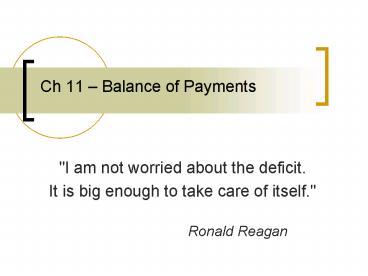Ch 11 Balance of Payments - PowerPoint PPT Presentation
1 / 10
Title:
Ch 11 Balance of Payments
Description:
Government transfer payments (Made by government, aid) Ch 11 Balance of ... Current Account Surplus. Exports are greater than imports of goods, services, etc. ... – PowerPoint PPT presentation
Number of Views:26
Avg rating:3.0/5.0
Title: Ch 11 Balance of Payments
1
Ch 11 Balance of Payments
- "I am not worried about the deficit.
- It is big enough to take care of
itself." Ronald Reagan
2
Ch 11 Balance of Payments
- Balance of Payments
- Record of all economic transactions between one
country and the rest of the world. - Uses double-entry accounting, where each
transaction has a debit and a credit. - Credit transactions () receipts from
foreigners (foreigners buy something from us). - Debit transactions (-) payments to foreigners
(we buy something from foreigners) - Credits gt debits surplus
- Debits gt credits deficit
3
Ch 11 Balance of Payments
- Sub Accounts
- Current Account
- Goods and services
- Merchandise trade balance
- exports and imports
- Services
- Restaurants, hotels, shipping, banking
- If Goods and Services balance is positive, there
is a surplus (added to GDP), meaning US has
transferred more resources to foreigners than
from foreigners over a given time period. - If Goods and Services is negative, there is a
deficit (subtracted from GDP), meaning US has
transferred more resources from foreigners than
to foreigners over a given time period. - Essentially, same as net exports (X) component of
GDP (Xexports imports)
4
Ch 11 Balance of Payments
- Sub Accounts
- Current Account (cont.)
- Investment income
- Earnings on US investments abroad minus payments
on foreign assets in US. - Not K movement, just return on K.
- Unilateral transfers
- Transfers of goods and services (gifts in kind,
not trade) or financial assets (money gifts)
between US and world. - Private transfer payments (movement between
individuals) - Government transfer payments (Made by government,
aid)
5
Ch 11 Balance of Payments
Current Account Balance, 2000 (millions of )
6
Ch 11 Balance of Payments
Current Account Balance, 2000 (millions of )
7
Ch 11 Balance of Payments
- Sub Accounts
- Capital Account
- Transfers of specific types of K, such as debt
forgiveness, transfers of real estate, such as
transfer of ownership of embassy or military
base. - Usually a very small, less important portion of
balance of payments.
- Financial Account
- Net changes in US owned assets abroad.
- Net changes in foreign owned assets in the US.
- Assets can include stocks, bonds, factories,
businesses, government reserves (foreign direct
investment and portfolio investment). - Flow changes (not stock) . . .Net changes (not
gross).
8
Ch 11 Balance of Payments
US Balance of Payments, 2000 (millions of )
9
Ch 11 Balance of Payments
- The current account and Capital account are
reflections of each other equal in absolute
value, one deficit, one surplus. - Statistical discrepancy (in 2000 35 billion)
used when they are NOT equal most errors in
reporting occur in financial account (more
difficult to track, only done quarterly). Dont
try this on your accounting test. - Current account deficit causes concerns
- Pushes down value of dollar, making imports more
expensive for domestic consumers. - Adversely impacts employment levels in certain
domestic industries, resulting from deteriorating
export levels (could be offset by job gains
resulting from counterbalanced financial
inflows). - Shouldnt ignore surpluses in services and
financial accounts when considering balance of
payments.
10
Ch 11 Balance of Payments
- Current Account Surplus
- Exports are greater than imports of goods,
services, etc. - Represents net receipt of financial claims on
other nations by the home nation. - These excess funds can be used to either build up
financial assets or reduce liabilities to rest of
world. - Home nation will become a supplier (lender) of
funds to the world.
- Current Account Deficit
- Imports are greater than exports of goods,
services, etc. - Represents net receipt of financial claims on
home nation by the rest of the world. - Home nation will borrow from other nations to pay
for imports, or will liquidate foreign assets. - Home nation will become a demander (borrower) of
funds from the world.































